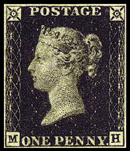TWO PENNY BLUE STAMPS
The Two Penny Blue postage stamp was the world’s second official stamp and was intended for double rate letters. The Two Penny Blue (technically the Two Pence Blue), are much rarer than Penny Blacks, more expensive and highly prised by collectors.
It was officially issued in May 1840, and looked the same as the Penny Black stamp, but in blue instead of black. Although the official issue date was 6th of May, 1840, there was some double about this as the earliest post mark seen on a two penny blue stamp was the 8th of May 1840, two days later than the Penny Black.
Although Penny Black and Two Penny Blue stamps were issued in May 1840, plans were already under way for their replacement. The decision to change the cancellation mark from red to black had also been made. In January 1840.
Rowland Hill wanted to see what the proposed new stamps would look like in the revised colours and requested that sheets of the new stamps be printed in the red brown ( which was eventually to be used for the new style penny stamp) as well as two sheets in blue - a full deep blue and Prussian blue. The Penny Blues, as these stamps became known as were thus an unissued postage British postage stamp that formed part of Rowlands Hills experiments with different coloured inks. Some of these ‘test’ blue stamps made it onto letters, but the fate of most of the 1840 test impression is unknown.
The plates used for these experiments was plate 8, originally used for printing Penny Blacks. The decision to use plate 8 was a random one - the plate was already on the presses being used.
A rare One Penny Blue stamp
As a result of Hill’s colour experiments, it was decided that the Two Penny blue would remain blue, but that different ink would be used. To distinguish the new style blue stamps from the old style blue ones, white lines were added during printing above and below the inscription. These are usually called the white lines added issue.

A white lines issue Two Penny Blue
Experimental stamps printed in the red-brown shade, if they made it onto letters as stamps, would be indistinguishable from later Penny Red printings as these were made in the same colour as part of the general issue in 1841.
Only 6 plates were used to print the Two Pence Blue. The original die used was called die 1. Plates 1 and 2 were imperforate. The stamps were identical to the Penny Black stamps except for the word 'TWO' and the blue printing ink. The stamps were printed on paper watermarked with a small crown and used alphabet 1.
Differentiating between plates 1 and 2
Plates 1 and 2 were imperforate. However, the following methods can be used to identify printings from plates 1 or 2.
- Location of the check letters
- Presence of a small notch on the 'O' and a joining of the 'TW" on TWO on most stamps from plate 2:

Identifying plates 3 and 4
Plates 3 and 4 were used in 1841. Stamps from these plates were imperforate, die I, alphabet I, but have the addition of white lines above TWOPENCE and below POSTAGE. Between 1854 and 1855, plate 4 was also issued perforated 14 and 16 on paper watermarked with a small crown.
Other identification features include the positions of the check letters, the appearance of the left border and irregularities in the letters of the words TWO PENCE on plate 3.
Identifying plate 5
Plate 5 used alphabet II which makes it easy to idently. The stamp was issued with both small and large crown watermarked paper. The stamps were perforated 14 or 16.
Identifying plate 6
Plate 6 used alphabet III and was only issued on paper with a large crown watermark and 14, 16 perforations. Another feature is that the white lines above and below with words are a bit thinner than on plates 3 to 5.
|




